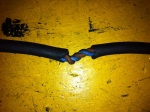Much is made of Personal Electrical Safety, yes it is of prime importance, however often Personal Safety takes precedence over concerns of fire safety and it gets left out of the Risk Assessment. As a result, little consideration is taken to reduce fire hazards in particular fire hazards concerning power boards and extension Leads. Over the years there has been an increase in the number of fires caused by electrical power-boards and leads. The origin of these fires has been identified as the improper use of electrical leads, and incorrect placement of power-boards.
By and large the most prevalent electrical fire faults have been attributed to the overloading of multiple outlet power-boards by electrical appliances which exceed the maximum rated output of the boards. This can cause the power-board to overheat, melt and catch fire. Included is the practice of placing double adaptors on power-boards to increase the number of power outlets, and the piggybacking of double adaptors on power points. These are extremely dangerous practices.
Most common Power-boards are designed with a 10 amp maximum rating and may incorporate up to eight power outlets. However, some electrical appliances such as Urns, Heaters, Toaster Ovens etc, can draw up to 4 amps for each item plugged in , making it relatively easy to exceed the power-board rating if all the outlets were in operation.
It is important that all your electrical appliances are used strictly according to manufacturer’s recommendations and ensure that any electrical appliances used individually or as a group do not exceed the power-boards maximum rating.
So What Can I do about it? (Prevention is the only way, cure is too late!)
- Ensure power-board rating is not exceeded by the appliances attached to the power-board.
- Do not use double adaptors in the Workplace (power boards cost just a little bit more and offer overload protection and more outlets)
- Never Chain from one power board to another to increase the number of power points.
- Conduct regular inspections of power-boards for visual damage or discolouring.
- If you suspect that a power-board is faulty, immediately take it out of service or replace it.
- Turn off powerboards at the power point when not in use.
- Ensure adequate ventilation around the power-board to prevent overheating.
- Use RCD protected Power Boards where fixed RCD protection is not available.
And don’t forget your Electrical Appliances.
- Provide adequate ventilation space around electrical appliances to allow heat to vent freely.
- Never operate electrical appliances in damp or wet areas.
- Not only turn electrical appliances off at their switch, but also to turn off the power point
- By taking these simple precautions the risk of fire starting from the use of electrical equipment can be minimised. Remember, above all, the best protection for you and your co-workers/employees is to have a properly installed and operating Smoke Alarm.
Update your Fire Emergency Plan and ensure that all staff know where to evacuate and assemble
<<<<<<<<<<<<<<<<<<<<<<<< 0 >>>>>>>>>>>>>>>>>>>>>>>>>>
Preparing your workplace for reducing fire hazards is important is important, however it is best that your appliances and electrical wiring are not hazardous in the first place. Tested & True ~ test & tag comes to your work place at a time convenient to you. We can do an assessment of your Electrical Hazards it can be conducted at the same time as we test and tag your Electrical Equipment. We provide a Full Report with recommedations to clear up current Hazards and how to prevent future risks. Call and ask for a quote. 040 7605568 Tested & True ~ test & tag Adelaide uses the very latest in Portable Appliance Testing…The STC ProLogger 2 it can perform RCD testing, Earth Leakage Detection and Run Testing all in one neat piece of equipment. On top this all our Technicians are Trained to National Standard UEENEEP008 in test & tag operations by Intertag in Sydney NSW, all our Equipment is in good repair and in Calibration. Most of all we pride ourselves on our Knowledge of OH&S legislation and the current Australiand Standards ensuring that you get Quality Service at a competitive price. Call Now Mobile 040 7605568
Visit us at http://www.testedandtrue.com.au or our Newsletter http://testedtruenewsletter.blogspot.com/
Peter Hill Manager , Tested & True ~ test & tag Adelaide February 2012





























